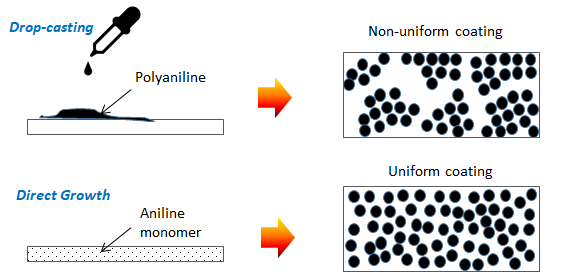Formation of Polyaniline (PANI) Multilayer Film using Humic Acid as the Bridging Agent: Screening on the Fabrication Technique
DOI:
https://doi.org/10.37934/progee.20.1.1623Keywords:
Polyaniline, Humic Acid, Direct Growth, Structural, Drop-castingAbstract
The application of polyaniline (PANI) in flexible electronic devices has received increased attention due to its environmental stability, electrical conducting properties, and ease of production. While the electrical conductivity of a PANI film can be altered by modifying the number of PANI layers, this study aims to compare two techniques, namely ex-situ and in-situ, for the fabrication of PANI multilayer film. For the ex-situ technique, PANI was formed separately before being drop-casted on a filter paper; on the other hand, for the in-situ technique, polymerization of aniline into PANI and attachment of PANI on a filter paper was allowed to occur simultaneously. In both techniques, humic acid was used as the bridging agent. Results showed that the in-situ direct growth technique produced PANI multilayer film with good uniformity, lesser cracking, and detachment. On the other hand, the ex-situ drop-casting technique resulted in PANI film with very poor uniformity, irregular thickness, and severe detachment.
References
E. N. Zare, P. Makvandi, B. Ashtari, F. Rossi, A. Motahari, and G. Perale, Progress in conductive polyaniline-based nanocomposites for biomedical applications: a review, Journal of Medicinal Chemistry 63 (2020) 1-22. https://doi.org/10.1021/acs.jmedchem.9b00803.
K. Hemalatha, G. Madhumitha, A. Kajbafvala, N. Anupama, R. Sompalle, and S. Mohana Roopan, Function of nanocatalyst in chemistry of organic compounds revolution: An overview, Journal of Nanomaterials 2013 (2013) 341015. https://doi.org/10.1155/2013/341015.
M. Saad, H. Tahir, J. Khan, U. Hameed, and A. Saud, Synthesis of polyaniline nanoparticles and their application for the removal of crystal violet dye by ultrasonicated adsorption process based on response surface methodology, Ultrasonics Sonochemistry 34 (2017) 600-608. https://doi.org/10.1016/j.ultsonch.2016.06.022.
S. Han, H. Yu, T. Yang, S. Wang, and X. Wang, Magnetic activated-ATP@Fe3O4 nanocomposite as an efficient fenton-like heterogeneous catalyst for degradation of ethidium bromide, Scientific Reports 7 (2017) 6070. https://doi.org/10.1038/s41598-017-06398-3.
H. X. Che, S. P. Yeap, M. S. Osman, A. L. Ahmad, and J. Lim, Directed assembly of bifunctional silica–iron oxide nanocomposite with open shell structure, ACS Applied Materials & Interfaces 6 (2014) 16508-16518. https://doi.org/10.1021/am5050949.
F. Wang and S. P. Yeap, Using magneto-adsorbent for methylene Blue removal: A decision-making via analytical hierarchy process (AHP), Journal of Water Process Engineering 40 (2021) 101948. https://doi.org/10.1016/j.jwpe.2021.101948.
T. Singh, S. Shukla, P. Kumar, V. Wahla, V. K. Bajpai, and I. A. Rather, Application of nanotechnology in food science: perception and overview, Frontiers in Microbiology 8 (2017) https://doi.org/10.3389/fmicb.2017.01501.
G. Piszter, G. Molnar, A. Palinkas, and Z. Osvath, Graphene-encapsulated silver nanoparticles for plasmonic vapor sensing, Nanomaterials 12 (2022) 2473. https://doi.org/10.3390/nano12142473.
M. O. Farea, H. A. Alhadlaq, Z. M. Alaizeri, A. A. A. Ahmed, M. O. Sallam, and M. Ahamed, High performance of carbon monoxide gas sensor based on a novel PEDOT:PSS/PPA Nanocomposite, ACS Omega 7 (2022) 22492-22499. https://doi.org/10.1021/acsomega.2c01664.
P. Liu, J. Yan, Z. Guang, Y. Huang, X. Li, and W. Huang, Recent advancements of polyaniline-based nanocomposites for supercapacitors, Journal of Power Sources 424 (2019) 108-130. https://doi.org/10.1016/j.jpowsour.2019.03.094.
Y. Li, M. A. Abedalwafa, L. Tang, D. Li, and L. Wang, Chapter 18 - Electrospun Nanofibers for Sensors, in Electrospinning: Nanofabrication and Applications, B. Ding, X. Wang, and J. Yu, Editors. 2019, William Andrew Publishing. p.p. 571-601.
Y. J. Prasutiyo, A. Manaf, and M. A. E. Hafizah, Synthesis of polyaniline by chemical oxidative polymerization and characteristic of conductivity and reflection for various strong acid dopants, Journal of Physics: Conference Series 1442 (2020) 012003. https://doi.org/10.1088/1742-6596/1442/1/012003.
M. Zhang, A. Nautiyal, H. Du, Z. Wei, X. Zhang, and R. Wang, Electropolymerization of polyaniline as high-performance binder free electrodes for flexible supercapacitor, Electrochimica Acta 376 (2021) 138037. https://doi.org/10.1016/j.electacta.2021.138037.
K. Bednarczyk, W. Matysiak, T. Tanski, H. Janeczek, E. Schab-Balcerzak, and M. Libera, Effect of polyaniline content and protonating dopants on electroconductive composites, Scientific Reports 11 (2021) 7487. https://doi.org/10.1038/s41598-021-86950-4.
G. A. Snook, P. Kao, and A. S. Best, Conducting-polymer-based supercapacitor devices and electrodes, Journal of Power Sources 196 (2011) 1-12. https://doi.org/10.1016/j.jpowsour.2010.06.084.
M. Myat Swe, T. Eamsa-ard, and T. Kerdcharoen, Fabrication of polyaniline coated conductive cotton for ammonia gas detection, MATEC Web Conf., 192 (2018) 02036.
G. Luo, L. Xie, M. He, R. Jaisutti, and Z. Zhu, Flexible fabric gas sensors based on reduced graphene-polyaniline nanocomposite for highly sensitive NH 3 detection at room temperature, Nanotechnology 32 (2021) 305501. https://doi.org/10.1088/1361-6528/abf455.
S. Majumdar, U. Saikia, and D. Mahanta, Polyaniline-Coated Filter Papers: Cost Effective Hybrid Materials for Adsorption of Dyes, Journal of Chemical & Engineering Data 60 (2015) 3382-3391. https://doi.org/10.1021/acs.jced.5b00645.
A. R. Ramos, A. K. G. Tapia, C. M. N. Piñol, N. B. Lantican, M. L. F. del Mundo, R. D. Manalo, and M. U. Herrera, Morphological, electrical and antimicrobial properties of polyaniline-coated paper prepared via a two-pot layer-by-layer technique, Materials Chemistry and Physics 238 (2019) 121972. https://doi.org/10.1016/j.matchemphys.2019.121972.
P.-G. Su and C.-C. Shiu, Flexible H2 sensor fabricated by layer-by-layer self-assembly of thin films of polypyrrole and modified in situ with Pt nanoparticles, Sensors and Actuators B: Chemical 157 (2011) 275-281. https://doi.org/10.1016/j.snb.2011.03.062.
P.-G. Su and Y.-S. Chuang, Flexible H2 sensors fabricated by layer-by-layer self-assembly thin film of multi-walled carbon nanotubes and modified in situ with Pd nanoparticles, Sensors and Actuators B: Chemical 145 (2010) 521-526. https://doi.org/10.1016/j.snb.2009.12.068.
P. J. Rivero, J. Goicoechea, and F. J. Arregui, Layer-by-Layer Nano-assembly: A Powerful Tool for Optical Fiber Sensing Applications, Sensors 19 (2019) 683. https://doi.org/10.3390/s19030683.
E. C. Gomes and M. A. S. Oliveira, Chemical polymerization of aniline in hydrochloric acid (hcl) and formic acid (HCOOH) media. Differences between the two synthesized polyanilines, American Journal of Polymer Science 2(2) (2012) 5-13. https://doi.org/10.5923/j.ajps.20120202.02.
N. Raval, R. Maheshwari, D. Kalyane, S. R. Youngren-Ortiz, M. B. Chougule, and R. K. Tekade, Chapter 10 - Importance of Physicochemical Characterization of Nanoparticles in Pharmaceutical Product Development, in Basic Fundamentals of Drug Delivery, R.K. Tekade, Editor 2019, Academic Press. p.p. 369-400.
M. Eslamian and F. Zabihi, Ultrasonic Substrate Vibration-Assisted Drop Casting (SVADC) for the Fabrication of Photovoltaic Solar Cell Arrays and Thin-Film Devices, Nanoscale Research Letters 10 (2015) 462-462. https://doi.org/10.1186/s11671-015-1168-9.
A. d. Kergommeaux, A. Fiore, J. Faure-Vincent, A. Pron, and P. Reiss, Colloidal CuInSe2 nanocrystals thin films of low surface roughness, Advances in Natural Sciences: Nanoscience and Nanotechnology 4 (2013) 015004. https://doi.org/10.1088/2043-6262/4/1/015004.
J. E. Ellis, S. E. Crawford, and K.-J. Kim, Metal-organic framework thin films as versatile chemical sensing materials, Materials Advances, 2 (2021) 6169-6196. https://doi.org/10.1039/d1ma00535a.
J. Jeon, V. Panchagnula, J. Pan, and A. V. Dobrynin, Molecular Dynamics Simulations of Mutilayer Films of Polyelectrolytes and Nanoparticles, Langmuir 22 (2006) 4629-4637. https://doi.org/10.1021/la053444n.

Downloads
Published
How to Cite
Issue
Section
License
Copyright (c) 2022 Progress in Energy and Environment

This work is licensed under a Creative Commons Attribution-NonCommercial 4.0 International License.











